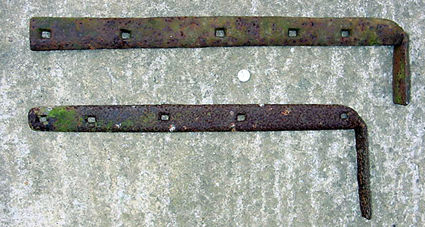HISTORIC IRONWORK REPAIRS IN TIMBER-FRAMED BUILDINGS.
Chapter 5
5. 16. A Note on Reworked and Re-used Iron.
Some ties exhibit features that seem out of place for their specific use. There can be two reasons for this. The first is that the tie is being re-used in a position that it was not originally designed for. It may be fitted unaltered or have been returned to the fire to be adapted. The second reason is that the tie has been manufactured from some other iron component. In this study it was found to have been a common practice to re-use cartwheel rims to make plates and ties (Fig. 5.43).

Fig. 5.43.
A pair of L-ties made from re-used cart tires from Ashes farm, Cressing, Essex.
The components may be 17th or 18th century but the crudity of the work suggests
the 19th century. Ties like these are difficult to date.
Prior to the 18th century cartwheel tires were made of several individual
strips of iron nailed end to end over the joints in the felloes of the rim
and not in a single piece shrunk onto the wheel. These plates have several
square pierced holes, often irregularly spaced that seem to have no use in
the design of the iron tie. The most diagnostic characteristic however is
that the section will be worn to a flat D shape where the tire has been run
on the road.
Much later, Victorian iron ties, often threaded draw-ties, replicate this section but not the irregularity of the holes or the pitted surface. Modern repairs of the Late 19th and 20th century use D-section handrail to replicate this tradition.
In trying to date these ties, the origin of the iron should be considered, but the typological features should be of the prime importance (Fig. 5.44).

Fig. 5.44. A pair of plates made from re-used cart tires. One has broken and been superseded by a well-wrought L-tie and this would suggest that they are all pre-Victorian. It is necessary to carefully examine the features of each tie to determine a likely period.
